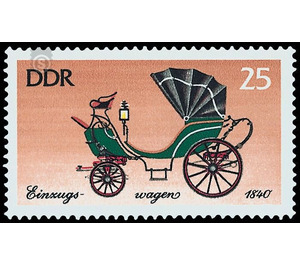Historic carriages - Germany / German Democratic Republic 1976 - 25 Pfennig
Theme: Post & Philately
| Country | Germany / German Democratic Republic |
| Issue Date | 1976 |
| Face Value | 25.00 |
| Color | brown |
| Perforation | K 14 |
| Printing Type | Rotogravure 2 |
| Stamp Type | Postage stamp |
| Item Type | Stamp |
| Chronological Issue Number | 1891 |
| Chronological Chapter | GER-DDR |
| SID | 519206 |
| In 26 Wishlists | |
Historic carriages The Ministry of Posts and Telecommunications of the German Democratic Republic issues six multicolored special postage stamps depicting historical carriages. Historic Carriages Four of the originals of the designs in this issue (10, 20, 35 and 50 Pfennig values) are in the collection of carriages of the museums in the castle of Augustusburg (Karl-Marx-Stadt district). The Kalesche on the 25-pfennig value is part of the stock of art collections in Weimar and the model of the stagecoach on the 40-pfennig value is in the collections of the postal museum of the GDR in Berlin. In the age of spaceships, airplanes and automobiles, the coach has almost completely disappeared from the horizon of today's generation as a means of transporting people and can usually only be admired as a "museum piece". While four-wheeled wagons were already known as work and load transport equipment in antiquity, the traces of the emergence of carriages can only be traced back to the 16th century. At that time, however, the use of carriages was a privilege of the high feudal nobility, and there was hardly a princely court in Europe that lacked city carriages and ceremonial carriages. However, the carriages issued in the castle Augustusburg come from a later construction period and belonged largely to the inventory of the former Royal Marstall in Dresden. After 1945 they were saved from further decay, transferred to Augustusburg and preserved and restored here with considerable state resources. The pictured Kalesche on the 25-pfennig value belonged to the stock of court carriages of the Grand Duchy of Saxony-Weimar-Eisenach. The vehicle was built in the first half of the 19th century in a local workshop, maybe even in the Weimerer Hofwagnerei, using metal parts that were already mass-produced at that time. The car has a strong, but for its provincial origin fairly light base, over which a slender, open superstructure with curly fenders in C-springs hangs. It is equipped with a folding top, painted brown and set off in black and has fire-gilt bronze fittings. The inside is lined with brown cloth. Pronounced elegantly is the attachment of the carriage lanterns, which rest on freestanding dainty supports. The coachman is mounted above a suitcase-like container, the "tonneau". Due to its open design, the vehicle was well suited for ceremonial-representative purposes, it was repeatedly used as a "pick-up car".


